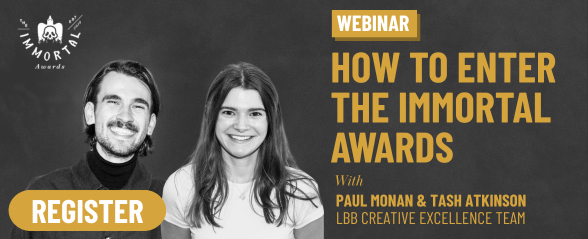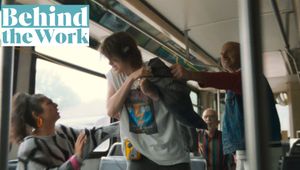
Why Pioneering Accessible Advertising Is an Exciting (and Lucrative) Opportunity

There’s a fundamental value to accessibility. You don’t have to get deeply philosophical to realise that it’s about how people can approach and interact with things. So it should be pretty uncontroversial to say that greater accessibility to advertising is good for brands.
That value of getting accessibility right was a major focus of the ‘Pioneering Accessible Advertising’ session at Advertising Week Europe, where in the introduction Katy Tilkowska, CEO of The Valuable 500 stressed the importance of “adopting the right mindset and not seeing it as just a compliance check." Accessibility is clearly an opportunity for brands to reach more consumers.
P&G has been pioneering accessible advertising, recently sharing an ambition to ensure 100% accessible advertising across Europe. Again, not as an act of charity or for its corporate image, but because 15% of consumers in Europe have some form of visual or hearing impairment. As Matt Thomas, senior director of brand function and media operations for P&G Northern Europe, said, too much advertising is still “actively excluding consumers from having a positive experience."
As a simple way to gauge where the industry is on this journey, he encouraged those with full hearing and sight to close our eyes and listen to an ad break, then see if we can understand it. The next ad break, he suggested we mute it and turn on the subtitles. "I guarantee you will have a poor experience," he says.
That’s why Matt enjoys a current industry quip that redefines ROI as ‘return on inclusion’. Inclusion is the right thing to do from both a human and a business perspective, he suggested.
Kate, whose organisation brings companies together to end disability exclusion, underlined this point with the value that is mostly being missed: $13 trillion in annual disability spending power that is overlooked, while 54% of disabled consumers are more likely to purchase from companies that adopt disability-inclusive values and represent disability authentically.
Henrietta Corley, business director at UK agency AMV BBDO has spoken to multiple clients about the value of making advertising more accessible and said that the conversations are easy. Brands are open and excited about the opportunities here, she said. But actually taking the steps to seize those opportunities is the hard part. She understands why. “It feels overwhelming, it feels daunting," she said. There are so many considerations to take. "It leads to a state of fear,” she continued, "That fear can lead to inaction, which is a shame."
The answer is often as simple as breaking the entire monolith of accessibility down so a brand doesn’t have to do everything at once. There are smaller things that can be changed that can make an impact, said Henrietta. Then once you prove the change can be made, it becomes a lot easier.
The AMV BBDO business director went on to repeat the misconception that investing in DE&I is an outlay, but the agency has found value for its clients in showing different narratives that another brand hasn’t. That creates cut though, noted Henrietta, which is sort of what it’s all about. “Creating that cultural and societal impact is definitely a reason why I work in advertising,” she said.
Opportunity aside, the European Accessibility Act is approaching in 2025. It seeks to ensure equal access to digital products and services throughout Europe and applies to any business that wishes to trade in the EU, wherever they may be based. It covers a wide range of goods and services. Regulatory authorities in a member state may impose fines on businesses that do not comply with the accessibility standards outlined in the EAA.
P&G is on a journey towards meeting its requirements for that, as should any business with more than 10 employees and a turnover of more than €2 million. Matt spoke about ways it is working with the broader industry to help brands meet the standards, for example, influencing the industry on closed captioning, which is now an opt-out decision when submitting campaigns to Clearcast, having previously been opt-in. "We are taking away one of those barriers and trying to ensure that as many brands as possible are making their ads accessible,” he said.
The consumer goods multinational is also working with partners such as Meta to get audio descriptions and closed captioning automatically generated for all of their brands’ ads.
Henrietta also underlined the importance of commitments with the help of industry organisations setting recommendations as a pull that can help the push being made by people who want to see their businesses make this transformation. She mentioned AMV BBDO’s new CEO Xavier Rees, who she said has already set "quite an ambitious vision" around the work the agency creates, who it hires and collaborates with. More information is coming on that soon, she said.
Then there’s the creative thrill that creating with more representation and inclusion brings. Ideas come from true insights about people’s lives, so involving different lived perspectives can only strengthen that. “That’s how we create beautiful meaningful, effective work,” said Henrietta.
When asked to share the bumps in the road in the interest of "progress, not perfection," Matt covered some frustrations around how regulation around marketing can sometimes work against disability inclusion. For example, mandatory legal supers make audio description almost impossible with audio description because there are simply too many words to be said in the time. That’s something P&G is working with the ASA to overcome. Tech is also still catching up. Linear providers and broadcasters need to provide an environment that makes closed captions and audio description easier to provide, he suggested.
"Progress over perfection," is a core value that Henrietta said should guide brands and agencies as they work towards better accessibility. Identifying the tangible changes that will provide that progress is key, such as changing briefs, changing the research process, and taking one small step that starts the journey. By way of an example, she shared the 2022 Guinness Africa work that the agency created about a blind man with a love for football. Working alongside Open Inclusion was the key to getting that work right, she said. It hadn’t started out perfectly, she admitted. A few months into the project, the agency decided to get more input from the blind community and "course correct". Research is a key stage of the creation process to make sure a campaign is getting things right. Henrietta admitted that unfortunately much research is still not representative enough, but she said that groups like Open Inclusion can help.
There’s a lot more to do. "Be healthily dissatisfied with the status quo," Matt urged the audience. And then when you know what needs fixing, ask yourself how you can do more to make progress.
Finally, Kate summed up the tone of the discussion, calling accessible advertising an “exciting opportunity, not a tick-box exercise." When brands all believe that, real progress will be made.















